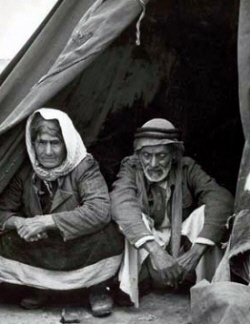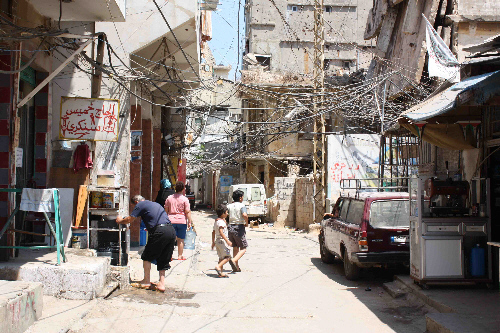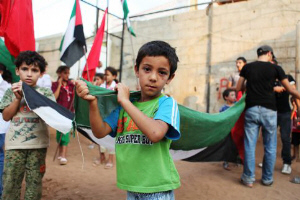"It was to the 11 shelters inside and on the edge of Shatila camp that the first arriving Kataeb (Phalanges) militiamen found their way through unfamiliar alleys and began their 46 hours of non-stop slaughter..."
 “My friends and I like Iran. Maybe they will ask their friends in Lebanon to help baba (daddy) to be allowed to work and our family allowed owning a home outside the camps.” Hanadi, a precocious youngster at Shatila Camp’s Shabiba center on learning last week from her teacher that Iran’s Supreme Leader Ali Khamenei and President Mahmoud Ahmadinejad warmly welcomed Palestinian leaders to Tehran during the 33rd anniversary celebrations of the 1979 Islamic Revolution and that both committed Iran to a “religious and moral duty to alleviate the effects on Palestinian refugees of the Nakba’s ethnic cleansing.”
“My friends and I like Iran. Maybe they will ask their friends in Lebanon to help baba (daddy) to be allowed to work and our family allowed owning a home outside the camps.” Hanadi, a precocious youngster at Shatila Camp’s Shabiba center on learning last week from her teacher that Iran’s Supreme Leader Ali Khamenei and President Mahmoud Ahmadinejad warmly welcomed Palestinian leaders to Tehran during the 33rd anniversary celebrations of the 1979 Islamic Revolution and that both committed Iran to a “religious and moral duty to alleviate the effects on Palestinian refugees of the Nakba’s ethnic cleansing.”
Around noon on Tuesday September 14, 1982, the day before Israel gave the green light for the launch of the three day Sabra-Shatila Massacre, two white vans pulled into Rue Sabra, diagonal from Akka Palestinian Hospital (PCRS), the main Shatila camp road.
Mrs. Halabi, a Palestinian teacher thought the four foreigners who exited the vehicles near the current Martyrs cemetery, were from a European NGO because they carried detailed maps of Shatila camp and she guessed that they might be assessing camp needs for an infrastructure project.
“Can you show us all the camp shelters?” she recalls one of the heavily accented men asking.
“Yes of course,” Mrs.Halabi replied and as the men followed her and took notes and photos, she explained that the shelters were too small to be of much use during “bombardments.”
“We understand”, said the apparent group leader, the only one their Palestinian guide recalls speaking during their visit, and then he added, “Why does this place smell so foul? Embarrassed by the question, Mrs. Halabi explained that the sewers in Palestinian camps, especially Shatila and nearby Burj al Barajneh are always in need of repair.”

We now know that the “European NGO delegation’ were in reality two Israeli intelligence agents accompanied by two Phalange intelligence operatives including their chief, Elie Hobeika. They arrived at Shatila camp for the purpose of identifying shelters where Palestinians would likely try to hide during the coming days.
And they succeeded.
It was to the 11 shelters inside and on the edge of Shatila camp that the first arriving Kataeb (Phalanges) militiamen found their way through unfamiliar alleys and began their 46 hours of non-stop slaughter. With very few exceptions all of the hundreds of refugees who huddled into the identified shelters were among the first to be massacred.
The Mossad organized group was not the only ones to complain about the sewer gases from Shatila. For weeks the Israeli troops sharing with Hobeika’s troops the HQ west of the camp at the Kuwaiti Embassy also complained to journalists that when the wind came off the mountains to the east and swept through the camp toward the sea behind them that they “could actually smell the Palestinian terrorists.”
30 years since the massacre at Sabra-Shatila, the camp sewer problem persists. When the wind blows eastward from the sea across Shatila camp, the Ghouberi Municipality offices located where the former Algerian Embassy stood in 1982 can smell the Shatila camp sewers just as the Israelis did. During the Sabra-Shatila massacre, the then Algerian Embassy gave sanctuary to refugees lucky enough to flee to the diplomatic compound which is about 50 meters from the eastern edge of Shatila camp. To do so, the survivors had to dodge five Israeli tanks positioned to block camp residents inside Shatila. Those who were caught were forced by Israel soldiers back into the death camp.
And those who today work to the east of Shatila in the Ghouberi Municipality offices and live nearby are not alone. If the wind happens to blow from north to south across Shatila camp and the Bir Hassan neighborhood it is the Iranian Embassy that receives the wafting foul air.
While the overwhelmed and broken camp sewers, lack of electricity, inadequate clean water, no heat in winter, no AC in summer, absence of sun light and fresh air, intense over-crowding-sometimes eight persons to a room, inadequate nutrition and health care, sky-rocketing respiratory disease, high dropout rates, increased drug usage, are among the seemingly endless problems in the 12 Palestinian refugee camps in Lebanon and impact every life, every day, recent words of solidarity from Iran are much appreciated.
According to Iran’s Supreme Leader Ali Khamenei, the Islamic Republic endorses the creation of a Palestinian state, regarding Israel as Palestine under occupation by the “Zionist regime”. Iran rejects a two state solution and considers that Palestine is indivisible and inseparable, probably reflecting a majority opinion today as support for Zionist Israel plummets globally.
 “Iran does not expect anything except endurance from Palestine’s resistance,” Khamenei was quoted as saying.
“Iran does not expect anything except endurance from Palestine’s resistance,” Khamenei was quoted as saying.
President Mahmoud Ahmadinejad, who had a very successful visit to Lebanon, last year, repeated his call for a free referendum for the entire Palestinian population, including Arab citizens of Israel, to determine the type of government in the future Palestinian state, while reiterating that establishment of a Palestinian state alongside Israel would “never mean an endorsement of the Israeli occupation”.
Iran’s Foreign Minister Ali Akbar Salehi told visiting Palestinians last week of “the need for Palestinian adherence to the basic principles of resistance as the key ingredient for their victory against Israel,” according to the official Iranian PRESS TV news agency.
PLO-Iranian Relations
Before the Iranian revolution, there was no Palestinian embassy in Iran. The Shah was much more interested in maintaining good relations with Israel and the United States, than in the Palestinians or in the Arab-Israeli peace process. The Palestinian Liberation Organization (PLO) developed close ties with the Iranian opposition, training Iranian dissidents at PLO camps in Lebanon
The PLO backed the 1979 revolution, and several days after the revolution, PLO chief Yasser Arafat led a Palestinian delegation to Iran. The Iranian Prime Minister Mehdi Bazargan hosted an official welcome ceremony for Arafat, where the keys to the former Israeli embassy were symbolically handed over to the PLO.
 However, the leader of the Islamic Revolution, Ayatollah Khomeini while supporting the Palestinian cause did not warm much to Arafat. During an intense two-hour meeting on Feb. 18, 1979, the ayatollah criticized the PLO for what he considered its limited nationalist and pan-Arab agenda. He urged Arafat to model the PLO on the principles of the Islamic revolution. While Arafat was an observant Muslim, he told aides why he rejected some of the ideas of Khomeini. Arafat and Khomeini never met again.
However, the leader of the Islamic Revolution, Ayatollah Khomeini while supporting the Palestinian cause did not warm much to Arafat. During an intense two-hour meeting on Feb. 18, 1979, the ayatollah criticized the PLO for what he considered its limited nationalist and pan-Arab agenda. He urged Arafat to model the PLO on the principles of the Islamic revolution. While Arafat was an observant Muslim, he told aides why he rejected some of the ideas of Khomeini. Arafat and Khomeini never met again.
As with most countries in the region, PLO-Iranian relations fluctuated, sometimes dramatically. They deteriorated fast when Arafat supported Iraq during the 1980-1988 Iran-Iraq war and again when Saddam invaded Kuwait. Iran condemned Arafat in 1988, after he recognized Israel, renounced terrorism, and called for peace talks with Israel. In 1989, Ayatollah Ali Khamenei named Arafat a “traitor and an idiot” and while the PLO maintained diplomatic relations with Tehran, Iran did not aid the PLO again until 2000.
Figuratively speaking, will Iran help fix the sewers in Lebanon’s camps and will the Iranian leadership ask their close Lebanese friends to enact the right to work and repeal the 2001 law that outlaws home ownership for Palestinians in Lebanon? Quite frankly, the absence of these very basic human rights in Lebanon negatively affects Palestinian lives day after day and not the goal of liberating Al Aqsa, however essential that is to achieve.
No right to work or home ownership please, they’re Palestinians!
“Miss International”, Zeinab al Hajj, born and raised in Shatila camp, regularly explains to visitors from Iran: “If we are allowed to work and own a home our capacity to engage in the liberation of Palestine will grow. As part of an economic middle class we could do more than struggling to put bread on our table for our children. We will have the energy and more time to resist the Zionist occupation of our country. Currently we are so forlorn — who among us has the energy to do more than just try to survive, not really live mind you, but try to survive and barely keep our families together.”
 A bit more than words of solidarity are needed from Iranian friends of Palestine to help them escape the sewers in which they exist not far from where their Muslim sisters and brothers and all foreigners in Lebanon enjoy full civil rights.
A bit more than words of solidarity are needed from Iranian friends of Palestine to help them escape the sewers in which they exist not far from where their Muslim sisters and brothers and all foreigners in Lebanon enjoy full civil rights.
During this 33rd Anniversary of the Islamic Revolution in Iran and the 30th anniversary of the 1982 Massacre at Sabra-Shatila, for the Iranian government to give solid achievement to its words and to facilitate the right to work and to own a home for Palestinian refugees in Lebanon would require Tehran, Beirut, and political forces in Lebanon, close ranks and push for a once-and-for-all solution to the refugees in Lebanon. Parliament should meet its Lebanese constitutionally mandated and internationally required obligation to immediately grant the basic human right of work and home ownership to its quarter million Palestinian refugees in Lebanon until they are able to return to their own country, Palestine.
 |
Franklin Lamb in doing research in Libya and can be reached c/o fplamb@gmal.com
He is the author of The Price We Pay: A Quarter-Century of Israel’s Use of American Weapons Against Civilians in Lebanon. Dr. Lamb is Director, Americans Concerned for Middle East Peace, Wash.DC-Beirut Board Member, The Sabra Shatila Foundation and the Palestine Civil Rights Campaign, Beirut-Washington DC |